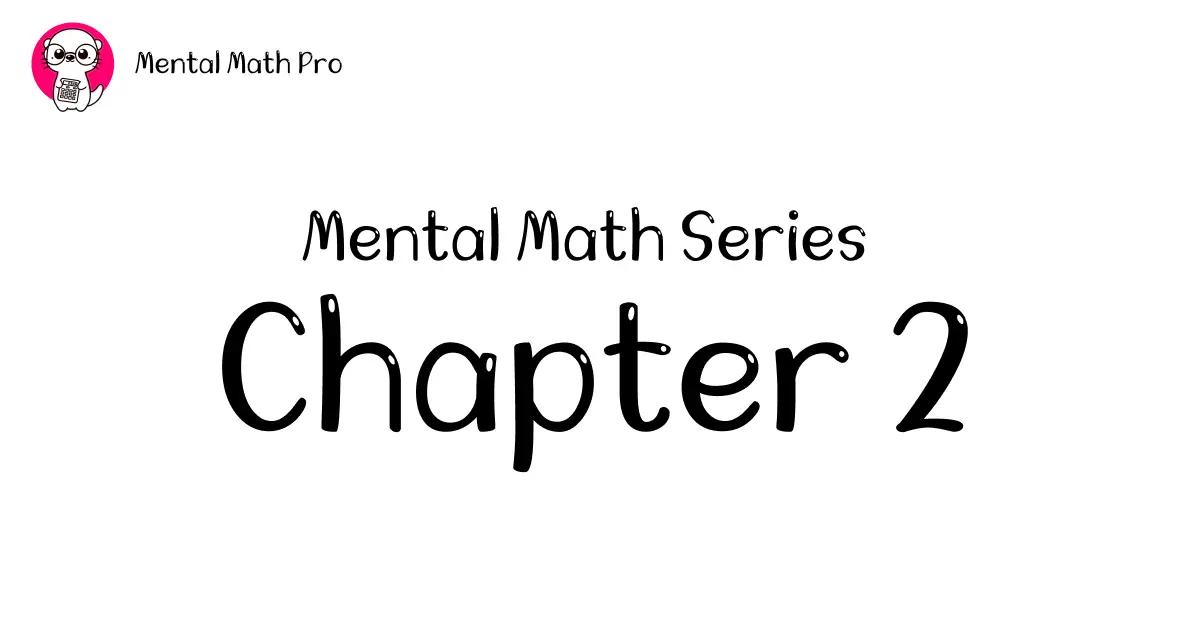How to Get Better at Mental Math: Proven Strategies!
7 min read · Jun 20, 2024

Table of contents
Hey there!
Welcome to the second chapter of my mental math series.
Today we're going to talk about the big question: How to get better at mental math?
Let's get straight into the nitty-gritty.
Fundamental Techniques
Rounding and Approximating
The first trick up our sleeve is rounding and approximating. This is how you're going to make tough calculations a whole lot easier.
Here's an example: Let's say you need to figure out 23 × 48.
Now, you could sit there and sweat it out… or you could be smart about it! Round that 48 up to 50. Now you've got 23 × 50, which is a cinch - it's 1150.
But we went a little high (by 2), right? So we need to subtract 23 × 2, which is 46. 1150–46 gives us 1104. Bam! Done in a fraction of the time.
This works for everyday stuff too. Say you're at a restaurant and need to figure out a 15% tip on a $37.82 bill. Round that up to $40. Take 10% of that ($4), then add half of that ($2). There's your tip - $6. Close enough, and you didn't even break a sweat 🙂
Using the Distributive Property
Next up, we've got the distributive property.
Sounds fancy, but it's really simple. It's just a way of breaking down big multiplications.
Let's take 16 × 23. Here's how you tackle it:
- Break 23 down into 20 + 3
- Do 16 × 20 = 320
- Then 16 × 3 = 48
- Add 'em together: 320 + 48 = 368
This trick is gold when one of your numbers is close to something round. Like 19 × 47. Think of it as (20–1) × 47. So that's (20 × 47) - 47 = 940–47 = 893. Easy as pie.
Mnemonic Devices
Now, let's talk about mnemonics. These are little memory tricks that'll help you keep all this math stuff in your head.
They work by creating memorable associations or patterns.
You've probably heard of this one, PEMDAS. That's how you remember the order of operations (Parentheses, Exponents, Multiplication, Division, Addition, Subtraction).
Sidenote: Some folks turn it into "Please Excuse My Dear Aunt Sally"... Erm whatever works for you.
For multiplication tables, you can get creative and create rhymes or visual associations.
Like to remember that 7 × 8 = 56, think "5, 6, 7, 8" as a sequence.
It's silly, but it sticks.
However, the best mnemonics are the ones you come up with yourself! The key is to make them vivid, unusual, or funny - whatever helps you remember.
Practice and Resources
Daily Exercises and Drills
I've said this once, and I'll say it again. You want to get good at mental math? You've got to practice a lot.
I recommend 30 hours as a start (so 1 hour a day for 30 days).
Start simple. Add and subtract two-digit numbers in your head. Then move on to multiplying single-digit numbers by two-digit numbers.
Sidenote: I designed a program that walks you though this step-by-step.
Time yourself and push yourself to go faster.
Math Apps and Websites
Now, I know most people are always on their phones. So let's put that to good use.
There are apps out there that can help you practice.
- Mental Math Pro (duh 😅): I couldn't recommend competitors without starting with my own tool. But I did try to make it the best way to learn mental math - and some people said I achieved that goal!
- Math Trainer AI: Another good option, and one cool thing are its leaderboards where you can compete against people in your city, country, and planet.
- FastMath: Very pretty iOS app. And it has high ratings! So highly recommended.
When you're picking an app or website, make sure it covers all your needs. Consider factors such as complexity, price, and how much care went into the design.
Books and Guides
For those who prefer a more traditional approach, there are some serious books out there.
We'll go into more details in a later chapter, but for now do yourself a favor and grab a copy of "Secrets of Mental Math" by Arthur T. Benjamin and Michael Shermer.
This one's got strategies for quick mental calculations (we're talking multiplying and dividing triple digits here).
Fun fact: A few days before I wrote this, the book went viral because one of Elon Musk's kids was reading it.
Advanced Strategies
Alright, now we're getting into the heavy stuff.
Trachtenberg Speed System
We have an entire section of the series dedicated to this.
But for now here's the kicker: You don't need multiplication tables. You just work one digit at a time, starting from the right.
And you use these things called "neighbors" - that's just the digit to the right of the one you're working on.
Let me show you how it works. Say we're multiplying 693 by 7:
- Start on the right: (3×2) + 0 + 5 + 0 = 11 (write down 1, carry 1)
- Move left: (9×2) + 1 + 5 + 1 = 25 (write down 5, carry 2)
- Keep going: (6×2) + 4 + 0 + 2 = 18 (write down 8, carry 1)
- Last step: (0×2) + 3 + 0 + 1 = 4
And there you have it: 4,851.
I know this made no sense! But hang in there. Like I said, we'll revisit Trachtenberg in more detail in a later chapter.
For now, just remember this system has shown incredible results. It can cut your calculation time by 20% with a 99% accuracy rate. Not too shabby, huh?
Arthur Benjamin's Methods
He's back! The author of the book we recommended.
This guy's not just a mathematician, he's a "mathemagician". And let me tell you, his tricks are something else.
One of his key strategies is the "addition method" for multiplication. Here's how it works for 23 x 46:
- Break down 46 into 40 + 6
- Calculate 23 × 40 = 920
- Calculate 23 × 6 = 138
- Add the results: 920 + 138 = 1058
He's also (like most mental math practitioners) big on working left to right in your head. It's not how they teach you in school, but it's faster and it lets you estimate as you go.
Criss-Cross and Other Techniques
Last but not least, we've got the criss-cross technique. This one's a lifesaver for two-digit multiplication. Here's how it goes:
- Multiply the ones digits of both numbers.
- Cross-multiply the tens digit of each number with the ones digit of the other number and add the results.
- Multiply the tens digits of both numbers.
- Put it all together, carrying over as necessary.
Let's try 23 x 14:
- Multiply ones: 3 x 4 = 12
- Cross-multiply: (2 x 4) + (3 x 1) = 8 + 3 = 11
- Multiply tens: 2 x 1 = 2
- Combine: 12 + 110 + 200 = 322
Once you've got this down pat, you'll be multiplying two-digit numbers faster than most people can punch them into a calculator.
Overcoming Challenges
Handling Pressure
Let's talk about keeping your cool when the heat is on.
Whether you're taking a test, interviewing for a job, or in some high-stakes math showdown, you've got to maintain mental clarity. Here's how:
- Don't think of it as a challenge. Think of it as a chance to show off what you can do and grow.
- Breathe, for crying out loud. Deep breaths. It'll calm you down.
- Break it down. Don't look at the whole problem. Take it step by step.
- Visualize success before you even start. It works.
- Talk to yourself. Tell yourself you've got this. Because you do.
- Focus on the present step of your calculation. Don't worry about the end result.
Remember, handling pressure is like anything else. The more you do it, the better you get.
Building Confidence
Now, let's talk about confidence. You've got to believe in yourself, or none of this matters:
- Start small. Work your way up. Don't bite off more than you can chew.
- Practice every day. You'll see tangible progress.
- Again, use positive self-talk to reinforce your abilities.
- Don't just memorize formulas! Understand what you're doing and why.
- Messed up? Good. That's how you learn.
- Celebrate your progress, no matter how small.
- Use your mental math skills in real life. See how it helps you.
Remember, building confidence takes time. Don't rush it. Just keep at it.
Continuous Improvement
Last but not least, let's talk about how you keep getting better:
- Set SMART goals (Specific, Measurable, Achievable, Relevant, Time-bound) for your practice.
- Use spaced repetition to review concepts and techniques at increasing intervals.
- Mix it up. Don't just practice one thing. Diversify to develop well-rounded skills.
- Track your progress. It provides tangible evidence of improvement.
- Seek feedback from others (I'm happy to help!). Find out where you need to improve.
- Keep pushing yourself. When it gets easy, make it harder.
If you do all this, you'll keep getting better. You'll bust through plateaus. And you'll be a mental math machine.
Conclusion
Here's the deal: Getting better at mental math isn't something that happens overnight. It's a journey, and it's going to take some real elbow grease.
But if you stick with it, if you put in the work, you're going to see results that'll knock your socks off.
See you in the next chapter 🙂 Be well.
About the author

Richard Reis
Founder of Mental Math Pro! Also currently doing a fun little "25 AI Startups in 50 Weeks" challenge.


![7 Mental Math Tricks: [Updated Guide]](/_next/image?url=%2Farticles%2Fchapter_3.webp&w=1920&q=75)